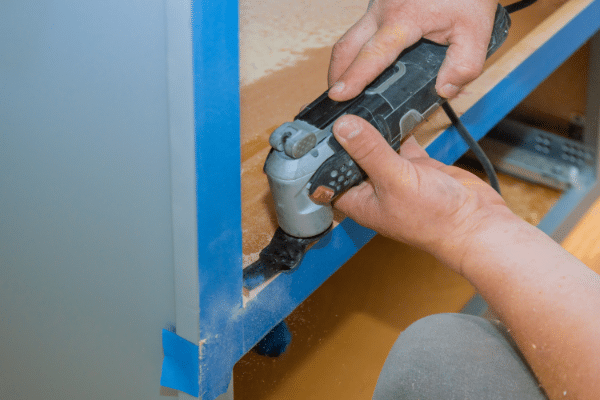
While you may not immediately reach for your oscillator when tackling timber — using a multi tool to cut wood offers a whole new world of versatility and flexibility.
Able to access areas traditional saws cannot reach and offering unparalleled control, these machines are essential for the keen DIYer, home-improver, woodworker, and trade contractor.
Sadly, many owners never consider their multipurpose cutting tools suitable for timber applications — which is unfortunate. Hence, why it’s essential for me to reveal the advantages and techniques for your wood projects.
So, here is your complete 101 to cutting wood with oscillating tool units.
What Oscillating Saw Blades Are Suitable for Wood?
With the multitude of oscillating blades on the market, it can initially appear challenging to select the consummate cutter for addressing timber.
However, it’s simple.
While shearing and trimming metal does require special considerations depending on the density and tensile strength of the material — for wood, there is just one blade you require, the bi-metal blade.
Admittedly, you could utilize a carbide, carbon steel, or diamond cutter — but that would be serious overkill, akin to making toast with a flamethrower. The bi-metal blade can cope with all species of dense and hardwoods, including stubborn oak, maple, and hickory.
In fact, the only consideration you have is whether to opt for a segmented or plunge bimetal cutter.
Segmented Blade
When you need to make linear cuts in timber, opt for segmented multi tool cutting blades. Their semicircular construction is ideal for straight-line shearing, in addition to trimming and finishing hard-to-access-areas.
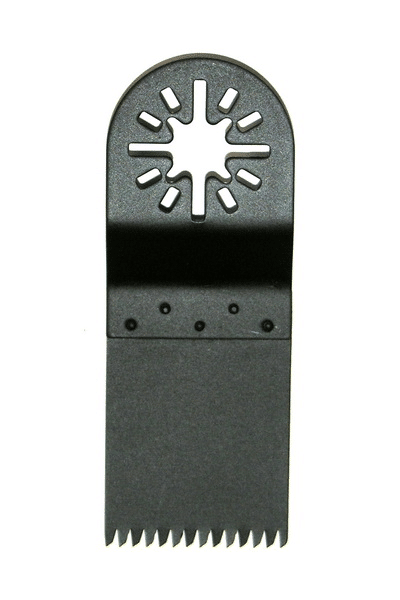
Plunge Cut Blade – Артём В., CC BY-SA 4.0, via Wikimedia Commons
Plunge Cut Blade
If you need to make recesses in wood, or tackle areas away from material edges, fit a plunge cut blade to your multi tool saw. Additionally, if you’re planning on undercutting baseboards or doors without unfixing them from the jamb or wall, the flat and angled build of the plunge cutter makes light work of accessing these confined spaces. A quick pro-tip… When choosing your bi-metal blade for wood, look for examples that offer substantial teeth and a large set (the angle of the teeth away from the blade). This will prevent clogging by allowing the timber dust, burrs, and splinters to disperse from the blade head.
When To Use an Oscillating Tool To Cut Wood
Although my mission in this article is to explain the benefits of using a multi tool oscillating saw to cut wood — they’re not suitable for all timber applications. Their most significant advantage is also, ironically, their greatest disadvantage — the blade size.
Small and compact, oscillating cutting tool units excel at fine finishing work, trimming, edging, and accessing confined spaces. They permit precise address, immense controllability, and accurate control.
However, where they fail is in thick timber applications. Naturally, you’re not going to try and fell that oak tree in your garden with a multitool — that’s the job of a chainsaw. But, even standard woodworking lumber can be too large for a single or double cut.
Resizing your timber with one cut is the ideal scenario — with a single pass ensuring a smooth and level trim. On wider cross-sections, you may need to address from two sides — with the cuts meeting in the middle.
Here’s a quick guide to whether your timber needs a single or double cut:
| Blade Type | Blade Size | Wood Thickness (inches | Wood Thickness (inches | Wood Thickness (inches | Wood Thickness (inches | Wood Thickness (inches | Wood Thickness (inches |
|---|---|---|---|---|---|---|---|
| Blade Size | Blade Size | 1" | 1.5" | 2" | 3" | 4" | 5" |
| Segmented | 3.5-inch | 2 sides | 2 sides | — | — | — | — |
| Segmented | 4-inch | 1 side | 2 sides | 2 sides | — | — | — |
| Plunge | 3-inch | 1 side | 1 side | 1 side | 1 side | — | — |
| Plunge | 3.25-inch | 1 side | 1 side | 1 side | 2 sides | 2 sides | — |
| Plunge | 3.5-inch | 1 side | 1 side | 1 side | 1 side | 2 sides | 2 sides |
So, as you can see above, any timber greater than five inches in thickness is impossible to address with a multitool — instead, utilize a table saw or circular saw.
Wood Cutting Using an Oscillating Saw
Assuming your blade can tackle the thickness of your timber, the number of wood-cutting applications is almost limitless. Here are the most common uses for utilizing an oscillator on timber materials.
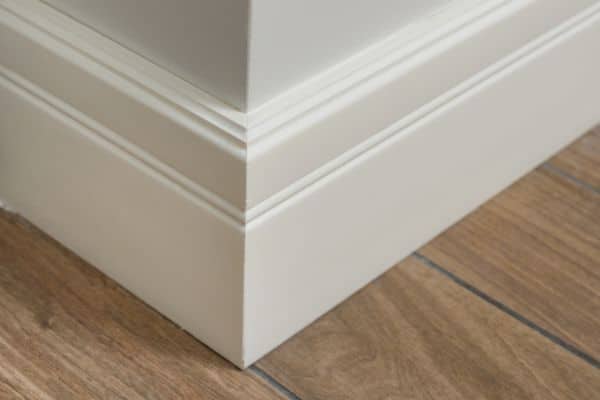
Cutting Baseboard With Oscillating Tool
For corners on baseboards — use a miter saw. Sure, you could attempt to make perfect 45-degree angles with your oscillating tool — but the results are likely to be less than impressive, and leave a gap around the edges that you could stick your fingers in.
But, when you need to resize, shape, or mold your baseboards to accommodate laminate, carpets, or uneven flooring — multitools are the ideal machines.
The long, flat, and offset-angled heads of plunge blades permit you to adjust the timber planks while in situ.
Undercutting Doors
In a similar fashion, you can utilize the advantages of the plunge blade to trim door bases. Negating the requirement of removal — typically a two-person project — you can shear small sections from the door foot. This is advantageous if your door has swollen or sticks due to thick carpets or parquet.
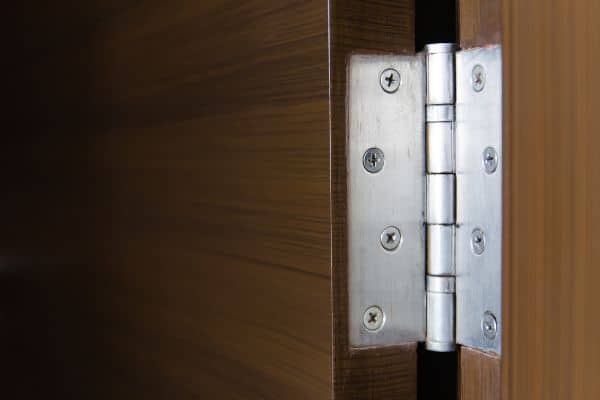
Recessing
Yet again, fit the versatile plunge blade to your vibrating saw tool, and you can create recesses in timber without having to drill pilot holes for a jigsaw. This permits you to create access for hinges, sinks, sockets, light switches, and step-lighting in decking.
Wood Sheeting
Multi cutting tool machines can address the most common formats of timber sheeting — including OSB (oriented strand board), MDF (medium-density fibreboard), particleboards, and plywood. Additionally, you can also tackle melamine-coated wood — but bear in mind that this dense laminate will rapidly wear your blade.
Fit a segmented blade to your vibrating cutter for straight cuts, while taking into account the limitations of timber thickness and considering whether you need to make a single or double cut.
Some quick advice.
If you need to make lengthy shears, ditch the idea of the multitool and use a circular saw instead. These larger machines will provide a truer and more consistent cut than the small blade of an oscillator. The multitool should be used on wood sheeting for trimming, shaping, recessing, and molding.
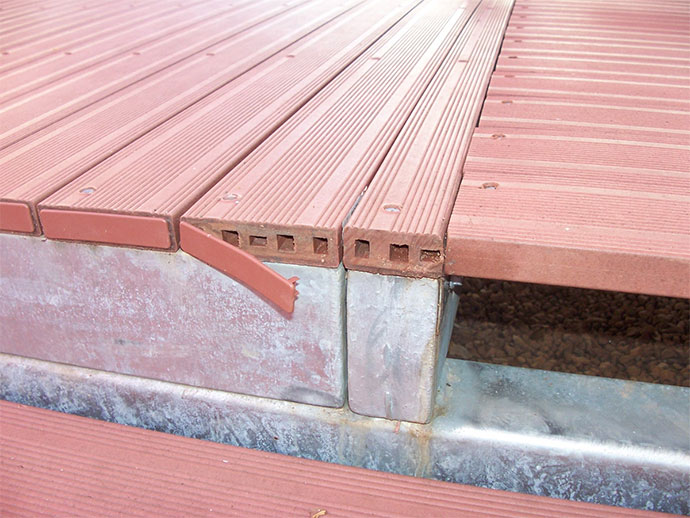
Billbeee at English Wikipedia, CC BY-SA 3.0, via Wikimedia Commons
Further Vibrating Wood Cutter Projects
In addition to the above, you can use your multi-tool to:
- Build cabinets.
- Make photo and picture frames.
- Reduce table and chair leg lengths.
- Trim and shape dado rails.
- Level fencing panels.
- Woodwork modeling projects.
- Shape and size picture rails.
- Finish decking.
Conclusion
Using an Oscillating MultiTool To Cut Wood and Timber FAQs
Q: Can You Use Multi-Tool To Cut Wood?
Yes! The compact size and maneuverability of oscillating multitools make them ideal for trimming, shaping, and molding timber.Q: How Do You Plunge Cut With a Multi-Tool?
Plunge cutting allows you to make recesses in timber without having to first create pilot holes. Here’s a video explaining the method:










